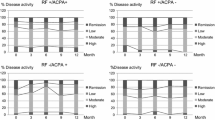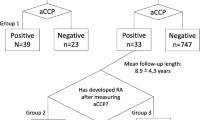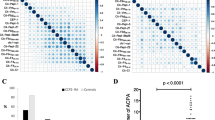Abstract
This study aimed to determine the frequency of rheumatoid factor (RF) and cyclic citrullinated peptide (CCP) antibodies in a cohort of patients with palindromic rheumatism (PR) and to find determinants for progression to rheumatoid arthritis (RA). All new cases of PR (n = 90) were included prospectively and followed up for 1 year, and a comparison group of RA cases (n = 70) was also included. At study entry in all patients in both groups, RF and anti-CCP antibodies were tested, and the findings were compared and correlated. In the PR group at presentation, RF was positive in 30 patients (33.3 %) and, in the RA group, in 45 patients (64.3 %). Anti-CCP antibodies were positive in 35 patients (38.9 %) with PR and in 58 patients (82.9 %) with RA. In the PR group, positive correlations were observed between RF and C-reactive protein (CRP) (p = 0.036), while anti-CCP positively correlated with disease duration (p = 0.015) and CRP (p < 0.001). At 1-year follow-up, 25 cases (27.5 %) had progressed to RA, 3 (3.3 %) cases had developed systemic lupus, 43 cases had responded to hydroxychloroquine with complete remission, five cases had developed other rheumatic diseases, and 14 cases had progressed to undifferentiated arthritis. After regression analysis, the involvement of hand joints and positive anti-CCP were the only predictors that determined progression into RA within a year (p < 0.001 and p = 0.02, respectively). Early hand joint involvement and positive anti-CCP at disease onset are good predictors for progression to RA in this domain.


Similar content being viewed by others
References
Hench P, Rosenberg E, Palindromic rheumatism (1944) A “new” recurring disease of joints (arthritis, periarthritis, para-arthritis) apparently producing no articular residues. Report of thirty-four cases; its relation to “angioneural arthrosis”, allergic rheumatism”, and rheumatoid arthritis. Arch Int Med 73:293–321
Hannonen P, Möttönen T, Oka M (1987) Palindromic rheumatism. A clinical survey of sixty patients. Scand J Rheumatol 16:413–420
Koskinen E, Hannonen P, Sokka T (2009) Palindromic rheumatism: longterm outcomes of 60 patients diagnosed in 1967–84. J Rheumatol 36:1873–1875
Powell A, Davis P, Jones N, Russell AS (2008) Palindromic rheumatism is a common disease: comparison of new-onset palindromic rheumatism compared to new-onset rheumatoid arthritis in a 2-year cohort of patients. J Rheumatol 35:992–994
Jacoby RK, Jayson MIV, Cosh JA (1973) Onset, early stages and prognosis of rheumatoid arthritis: a clinical study of 100 patients with 11 years follow-up. BMJ 2:96–100
Lee W, Weisman MH (2006) The predictive power of anti-cyclic citrullinated peptide antibodies: window into understanding gene/environment/immunity interactions. J Rheumatol 33:1216–1218
Salvador G, Gomez A, Vinas O, Ercilla G, Canete JD, Munoz-Gomez J, Sanmarti R (2003) Prevalence and clinical significance of anti-cyclic citrullinated peptide and antikeratin antibodies in palindromic rheumatism. An abortive form of rheumatoid arthritis? Rheumatology 42:972–975
Jansen AL, van der Horst-Bruinsma I, van Schaardenburg D, van de Stadt RJ, de Koning MH, Dijkmans BA (2002) Rheumatoid factor and antibodies to cyclic citrullinated peptide differentiate rheumatoid arthritis from undifferentiated polyarthritis in patients with early arthritis. J Rheumatol 29:2074–2076
van Gaalen FA, Linn-Rasker SP, van Venrooij WJ, de Jong BA, Breedveld FC, Verweij CL, Toes RE, Huizinga TW (2004) Autoantibodies to cyclic citrullinated peptides predict progression to rheumatoid arthritis in patients with undifferentiated arthritis: a prospective cohort study. Arthritis Rheum 50:709–715
Emad Y, Shehata M, Ragab Y, Saad A, Hamza H, Abou-Zeid A (2010) Prevalence and predictive value of anti-cyclic citrullinated protein antibodies for future development of rheumatoid arthritis in early undifferentiated arthritis. Mod Rheumatol 20:358–365
van der Linden MP, van der Woude D, Ioan-Facsinay A, Levarht EW, Stoeken-Rijsbergen G, Huizinga TW, Toes RE, van der Helm-van Mil AH (2009) Value of anti-modified citrullinated vimentin and third-generation anti-cyclic citrullinated peptide compared with second-generation anti-cyclic citrullinated peptide and rheumatoid factor in predicting disease outcome in undifferentiated arthritis and rheumatoid arthritis. Arthritis Rheum 60:2232–2241
Omar A, Abo-Elyoun I, Hussein H, Nabih M, Atwa H, Gad S, Emad Y (2013) Anti-cyclic citrullinated peptide (anti-CCP) antibody in juvenile idiopathic arthritis (JIA): correlations with disease activity and severity of joint damage (a multicenter trial). Joint Bone Spine 80:38–43
Gonzalez-Lopez L, Gamez-Nava JI, Jhangri GS, Ramos-Remus C, Russell AS, Suarez-Almazor ME (1999) Prognostic factors for the development of rheumatoid arthritis and other connective tissue diseases in patients with palindromic rheumatism. J Rheumatol 26:540–545
Guerne PA, Weisman MH (1992) Palindromic rheumatism: part of or apart from the spectrum of rheumatoid arthritis. Am J Med 93:451–460
Koskinen E, Hannonen P, Sokka T (2009) Palindromic rheumatism: long term outcomes of 60 patients diagnosed in 1967–84. J Rheumatol 36:1873–1875
Russell AS, Devani A, Maksymowych WP (2006) The role of anti-cyclic citrullinated peptide antibodies in predicting progression of palindromic rheumatism to rheumatoid arthritis. J Rheumatol 33(7):1240–1242
Chen HH, Lan JL, Hung GD, Chen YM, Lan HH, Chen DY (2009) Association of ultrasonographic findings of synovitis with anti-cyclic citrullinated peptide antibodies and rheumatoid factor in patients with palindromic rheumatism during active episodes. J Ultrasound Med 28:1193–1199
Tamai M, Kawakami A, Iwamoto N, Arima K, Aoyagi K, Eguchi K (2010) Contribution of anti-CCP antibodies, proximal interphalangeal joint involvement, HLA-DRB1 shared epitope, and PADI4 as risk factors for the development of rheumatoid arthritis in palindromic rheumatism. Scand J Rheumatol 39:287–291
Aletaha D, Neogi T, Silman AJ, Funovits J, Felson DT, Bingham CO 3rd et al (2010) Rheumatoid arthritis classification criteria: an American College of Rheumatology/European League Against Rheumatism collaborative initiative. Arthritis Rheum 62:2569–2581
Sanmarti R, Canete JD, Salvador G (2004) Palindromic rheumatism and other relapsing arthritis. Best Pract Res Clin Rheumatol 18:647–661
Maksymowych WP, Suarez-Almazor ME, Buenviaje H, Cooper BL, Degeus C, Thompson M, Russell AS (2002) HLA and cytokine gene polymorphisms in relation to occurrence of palindromic rheumatism and its progression to rheumatoid arthritis. J Rheumatol 29:2319–2326
Kim SK, Lee HS, Bae SC, Jun JB (2006) Palindromic rheumatism: different genetic background implies a distinct disease entity. Ann Rheum Dis 65:1539–1540
Khabbazi A, Hajialiloo M, Kolahi S, Soroosh M, Esalatmanesh K, Sharif S (2012) A multicenter study of clinical and laboratory findings of palindromic rheumatism in Iran. Int J Rheum Dis 15:427–430
Sanmartí R, Cabrera-Villalba S, Gómez-Puerta JA, Ruiz-Esquide V, Hernández MV, Salvador G, Ramirez J, Viñas O, Cañete JD (2012) Palindromic rheumatism with positive anticitrullinated peptide/protein antibodies is not synonymous with rheumatoid arthritis. A long term follow up study. J Rheumatol 39:1929–1933
Cañete JD, Aróstegui JI, Queiró R, Sanmartí R, Ballina J, Bosch X, Yagüe J (2006) Association of intermittent hydrarthrosis with MEFV gene mutations. Arthritis Rheum 54:2334–2335
Samuels J, Aksentijevich I, Torosyan Y, Centola M, Deng Z, Sood R, Kastner DL (1998) Familial Mediterranean fever at the millennium: clinical spectrum, ancient mutations, and a survey of 100 American referrals to the National Institutes of Health. Medicine (Baltimore) 77:268–297
The International FMF Consortium (1997) Ancient missense mutations in a new member of the RoRet gene family are likely to cause familial Mediterranean fever. Cell 90:797–807
Bernot A, Clepet C, Dasilva C, Devaud C, Petit JL, Caloustian C, Cruaud C, Samson D et al (1997) The French Consortium. A candidate gene for familial Mediterranean fever. Nat Genet 17:25–31
Vayssade M, Tatar Z, Soubrier M (2013) Palindromic rheumatism. Rev Med Interne 34:47–52
Cañete JD, Arostegui JI, Queiró R, Gratacós J, Hernández MV, Larrosa M, Alperí M, Moll C, Rius J, Sanmartí R, Yagüe J (2007) An unexpectedly high frequency of MEFV mutations in patients with anti-citrullinated protein antibody-negative palindromic rheumatism. Arthritis Rheum 56:2784–8
Disclosures
All the authors responsible for this work declare no conflicts of interest.
Author information
Authors and Affiliations
Corresponding author
Rights and permissions
About this article
Cite this article
Emad, Y., Anbar, A., Abo-Elyoun, I. et al. In palindromic rheumatism, hand joint involvement and positive anti-CCP antibodies predict RA development after 1 year of follow-up. Clin Rheumatol 33, 791–797 (2014). https://doi.org/10.1007/s10067-014-2569-3
Received:
Revised:
Accepted:
Published:
Issue Date:
DOI: https://doi.org/10.1007/s10067-014-2569-3




